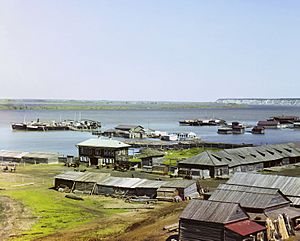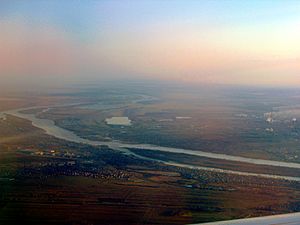Irtysh facts for kids
Quick facts for kids Irtysh |
|
|---|---|

Irtysh watershed
|
|
| Country | Mongolia, China, Kazakhstan, Russia |
| Cities | Oskemen, Semey, Pavlodar, Omsk, Tobolsk, Khanty-Mansiysk |
| Physical characteristics | |
| Main source | near Mang-tai-ch’ia-ta-fan pass, Altai Mountains, Xinjiang, China 2,960 m (9,710 ft) 47°52′39″N 89°58′12″E / 47.87750°N 89.97000°E |
| River mouth | Ob 61°05′24″N 68°49′15.60″E / 61.09000°N 68.8210000°E |
| Length | 4,248 km (2,640 mi) |
| Basin features | |
| Progression | Ob→ Kara Sea |
| Basin size | 1,643,000 km2 (634,000 sq mi) |
The Irtysh River is a very long river that flows through three countries: China, Kazakhstan, and Russia. It's a major branch of the Ob River and is actually the longest tributary river in the world. A tributary is a smaller river or stream that flows into a larger river.
The Irtysh starts high up in the Altai Mountains in China. From there, it travels a huge distance, eventually joining the Ob River in Western Siberia, Russia. The Irtysh and Ob rivers together form a massive drainage basin. This is like a giant bowl that collects all the water from a large area of Asia, including most of Western Siberia.
Contents
Where the Irtysh River Flows
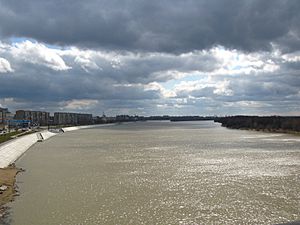
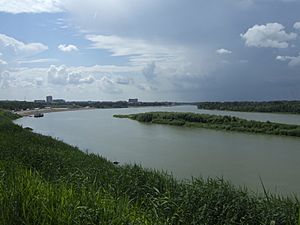
The Irtysh River begins in the Altai Mountains in China. Here, it's sometimes called the Kara-Irtysh, which means "Vast Irtysh".
As it flows, the river goes through Lake Zaysan in Kazakhstan. After the lake, it meets other rivers like the Ishim River and the Tobol River. Finally, after flowing for about 4,248 kilometers (2,640 miles), it joins the Ob River near Khanty-Mansiysk in Russia.
Rivers Joining the Irtysh
Many smaller rivers flow into the Irtysh. These are its main tributaries, listed from where the Irtysh starts to where it ends:
- Kelan (from the right side)
- Burqin (right)
- Kalzhyr (right)
- Kürshim (right)
- Naryn (right)
- Bukhtarma (right)
- Ulba (right)
- Uba (right)
- Chagan (from the left side)
- Om (right)
- Tara (right)
- Uy (right)
- Osha (left)
- Shish (right)
- Ishim (left)
- Tobol (left)
- Noska (left)
- Demyanka (right)
- Konda (left)
How People Use the Irtysh River
The Irtysh River is very important for transportation and power.
- Boats and Ships: In Kazakhstan and Russia, large boats like tankers (which carry liquids) and Cargo ships (which carry goods) use the river. Passenger boats also travel on it. This happens during the warmer months, usually from April to October, when the river isn't frozen. The city of Omsk in Russia is a major river port (a place where ships load and unload) in Western Siberia.
- Hydroelectric Power: In Kazakhstan, there are three big hydroelectric power plants on the Irtysh. These plants use the force of the river's water to create electricity. They are located at Bukhtarma, Ust-Kamenogorsk, and Shulbinsk. There's even a very deep lock at Ust-Kamenogorsk. A lock is like a water elevator that helps boats move past a dam by raising or lowering the water level.
- Dams in China: China has also built several dams on its part of the Irtysh River. These include the Keketuohai Dam and the Kalasuke Dam. Dams are also built on smaller rivers that flow into the Irtysh, like the Burqin River and the Haba River.
- Canals: The Irtysh River's water is also used for irrigation (watering crops) and to supply water to cities.
- The Irtysh–Karaganda Canal was built in Kazakhstan to bring water to dry areas and to the industrial city of Karaganda. Pipelines were later added to send water to Kazakhstan's capital, Nur-Sultan.
- In China, a canal was built to send some Irtysh water to Lake Ulungur. Later, a much bigger project, the Irtysh–Karamay–Urümqi Canal, was completed to supply water to cities like Karamay and Ürümqi. This increased use of water in China has made environmentalists in Kazakhstan and Russia worried about the river's flow.
Cities Along the Irtysh
Many important cities are located along the Irtysh River. Here are some of them, listed from the river's source to its mouth:
- In China: Fuyun, Beitun, Burqin
- In Kazakhstan: Oskemen, Semey, Aksu, Pavlodar
- In Russia: Omsk, Tara, Tobolsk, Khanty-Mansiysk
Bridges Over the Irtysh
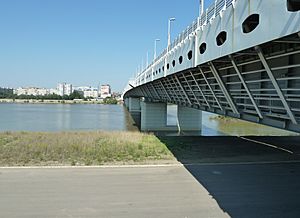
Many bridges cross the Irtysh River, helping people and goods travel. There are seven railway bridges, which means trains can cross the river at these points:
- Near Serebryansk
- Oskemen
- Semey, part of the Turkestan–Siberia Railway
- Pavlodar, on the South Siberian rail line
- Near Cherlak, on the Middle Siberian rail line
- Omsk, on the famous Trans-Siberian Railway. This is the oldest bridge on the river, built in 1896.
- Tobolsk, on the Tyumen-Surgut line
Many highway bridges also cross the Irtysh in all three countries it flows through. The very last bridge on the Irtysh, a highway bridge, was opened in 2004 in Khanty-Mansiysk. It's located just before the Irtysh joins the Ob River.
History of the Irtysh River Region
For many centuries, different groups of people, like the Mongols and Turkic peoples, lived along the banks of the Irtysh River.
In the 15th and 16th centuries, the lower and middle parts of the Irtysh were part of the Tatar Khanate of Sibir. Its capital city, Qashliq, was located on the Irtysh.
The Russians later conquered the Khanate of Sibir in the 1580s. They started building their own towns and fortresses along the river. One of the first Russian towns in Siberia was Tobolsk, founded in 1587. Another important town, Tara, was founded in 1594.
In the 17th century, the Dzungar Khanate, formed by the Mongol Oirat people, controlled the upper part of the Irtysh. As Russia expanded, they built more cities along the river to protect their borders and trade routes. These cities included Omsk (founded in 1716), Semipalatinsk (1718), and Ust-Kamenogorsk (1720).
The Chinese Qing Empire took control of the Dzungar region in the 1750s. This led to the Russian and Chinese empires carefully defining their borders along the Irtysh River. The exact border was set by agreements like the Convention of Peking in 1860 and later adjusted by the Protocol of Chuguchak in 1864, which placed Lake Zaysan on the Russian side.
Other Uses of the Name Irtysh
The name "Irtysh" is also used for other things, especially in sports:
- FC Irtysh Omsk: A soccer team in Omsk, Russia.
- FC Irtysh Pavlodar: A soccer team in Pavlodar, Kazakhstan.
- Irtysh (Иртыш): A Russian military hospital ship.
See also
 In Spanish: Río Irtish para niños
In Spanish: Río Irtish para niños
- Geography of China
- Geography of Kazakhstan
- Geography of Russia



